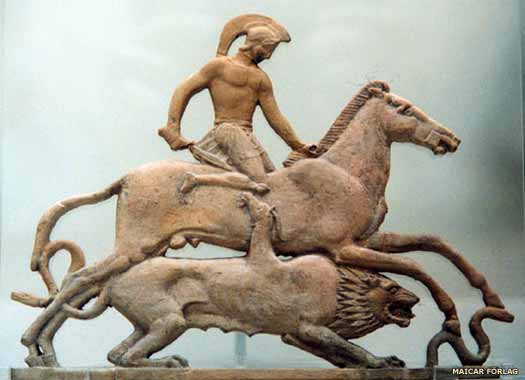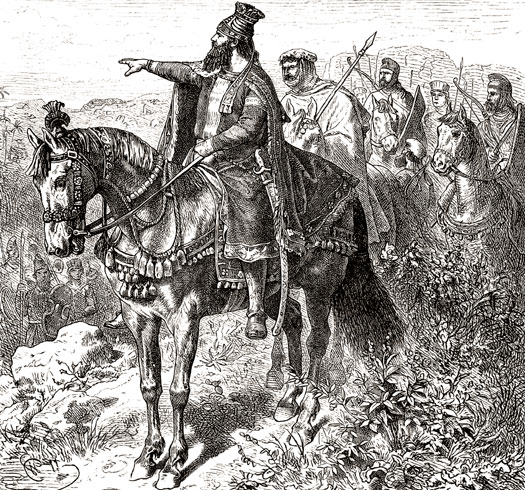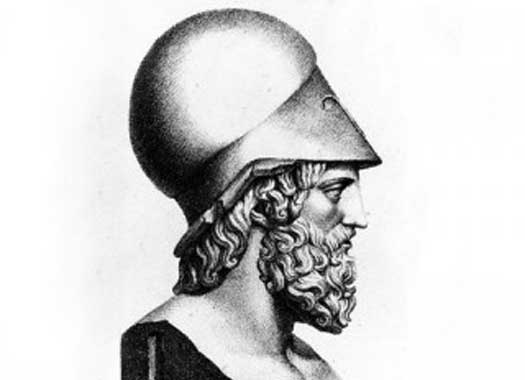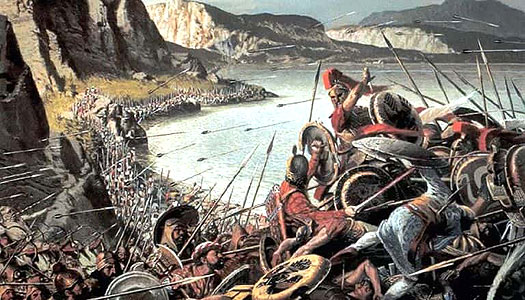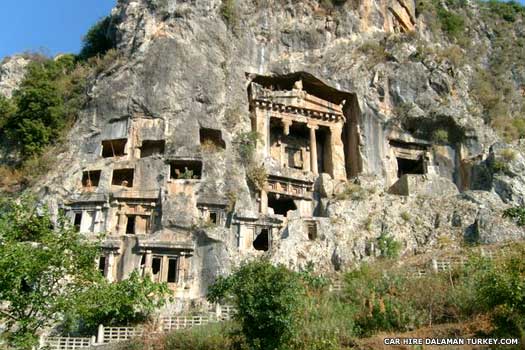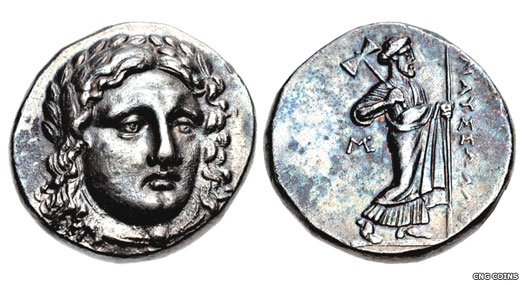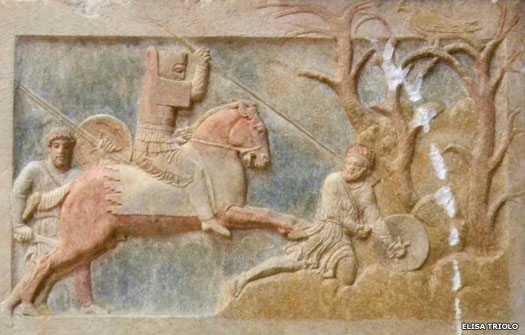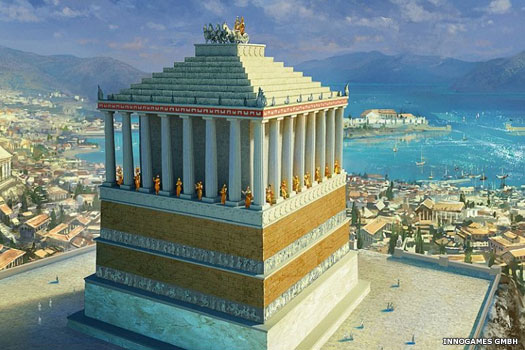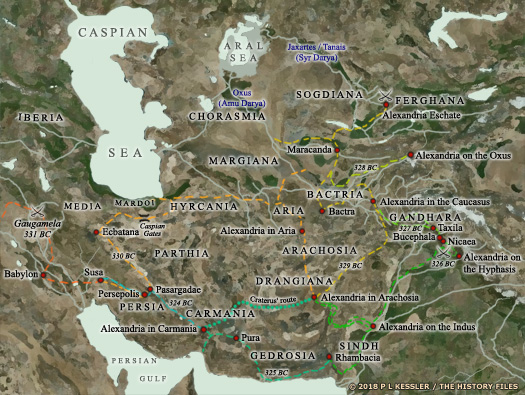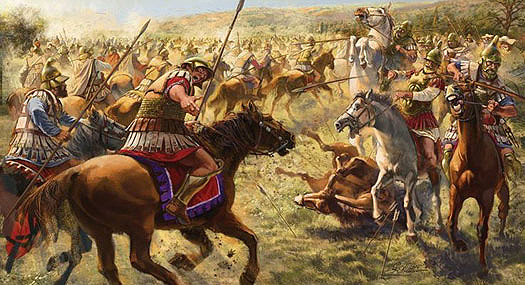
| KARKISSA / KARKIYA (CARIA) Karkissa (or Karkija, Greek Caria) is mentioned only once in cuneiform texts from the Hittite and Assyrian empires. It was situated on the extreme south-western corner of Anatolia, opposite Rhodes and immediately to the west of the Lukka (later Lycia). While its people were probably Luwian-speaking Indo-Europeans related to the Lukka or Arzawans, there is almost no history for the region before the sixth century BC. Interestingly, there is also a lack of prehistoric archaeology for the interior of Caria, but some inscriptions that have been found in Egypt have been deciphered and are classed as being Indo-European of the Anatolian group (see feature link for more on the Anatolian group of Indo-European languages).
Caria is mentioned by Homer, who includes it amongst the allies of Troy. He names their capital as Miletus which, around 1240 BC, is better ascribed to Ahhiyawa, but he does confirm that they are indigenous to the area. However, if the stories of the Trojan War are to be believed, the Carians did not speak a recognisable western Anatolian language, so perhaps they had already been influenced by Greeks. Following the Mycenaean victory at Troy, the Greeks heavily settled the Anatolian coast between about 1200-800 BC, including Caria where the locals at Miletus spoke Greek with an Ionian accent. Herodotus (himself a native of Halicarnassus in Caria) states that Carians were Minoan in origin - unlikely, although Minoan traders or refugees could have settled there and Artemisia (I) of Halicarnassus was half Cretan through her mother. The Carians themselves insisted they were Anatolians (which meant an admixture of Neolithic farmers and Luwians), similar to the Lydians and Mysians. Caria's more concrete history begins with the Persian conquest of the region in 546 BC.
(Information by Peter Kessler, with additional information by Edward Dawson, from Hittite Diplomatic Texts, Gary Beckman (Second Edition, 1999), from The Kingdom of the Hittites, T Bryce (1998), from The Histories, Herodotus (Penguin, 1996), from The Oxford Classical Dictionary, Simon Hornblower, Antony Spawforth, & Esther Eidinow (Oxford University Press, 2012), and from External Link: Hittites.info (dead link).)
c.1336 - 1333? BC :
Manapa-Tarhunta of Arzawa escapes a plot by his brothers to kill him by fleeing to Karkissa. Hittite joint kings Mursili II and his incapacitated brother, Arnuwanda, both write to the men of Karkissa, asking them to keep Manapa-Tarhunta safe.
fl 1230s? BC :
Amisodarus : King of Caria in Greek mythology.
c.1230s? BC :
The Chimera (or Khimaira) in Greek mythology is a monstrous beast which ravages the countryside of Lycia. Raised by Amisodarus, Bellerophon is ordered to destroy it by King Iobates of Lycia (late Classical writers represent the beast as a metaphor for a Lycian volcano).
Terracotta relief showing Bellerophon fighting the Chimera, made in Melos in about 450 BC fl c.1180s BC :
Nastes : Ally of Troy.
c.1193 - 1183 BC :
Karkissa (Caria) is traditionally an ally of Troy during the Trojan War against Mycenae and the collected forces of the Achaean kingdoms, although its 'barbarian' language places it a little apart from the main Trojan allies. The Carian troops are led by Nastes and Amphimachus, sons of Nomion, but the latter is killed by Achilles after going 'into battle like a girl, decked in gold'.
c.1200 BC :
It is possible that a minor state of Caria briefly flourishes during the period in which Hittite influence in Anatolia is waning, but it seems likely that it is afterwards pulled into whatever local administration is formed by the new wave of Greek settlers, which unfortunately remains unknown.
Caria (KarkÔ) :
A fairly backwards and divided country by international standards of the time, Caria had been a subject state of the Lydians by the time it was conquered by the Persians in 546 BC. The capital was now Halicarnassus (modern Bodrum), which had originally been founded by Greek settlers. Established as the satrapy of KarkÔ, which also included Lykia, the Carians were already famous as mercenaries. Retaining a level of independence at first, Caria gained what was probably full autonomy within the empire in 499 BC.
One of its most famous sons is Herodotus of Halicarnassus, the fifth century BC Greek researcher. His father was Lyxes, a Greek rendering of a good Carian name, Lukhsu.
Caria's leading city was Miletus. It is mentioned is by Homer, who includes it amongst the allies of Troy. In that period - the late thirteenth or early twelfth century BC - Miletus is better ascribed to Ahhiyawa, potentially a Mycenaean colony. Even if the majority of the Carian people were Anatolians, any external (Mycenaean) takeover would have seen their social structure being overlaid by a new layer of nobility.
(Additional information from Hittite Diplomatic Texts, Gary Beckman (Second Edition, 1999), from The Kingdom of the Hittites, T Bryce (1998), from The Persian Empire, J M Cook (1983), from The Histories, Herodotus (Penguin, 1996).)
c.1068 BC :
Codros of Athens sacrifices himself to prevent an oracle regarding the Doric conquest of the city from coming true. In doing so, he preserves the Mycenaean bloodline that survives in Athens when all of Greece has fallen to the Dorians. His heirs become hereditary Archons, or lords, of Athens, with his son, Medros, the first of these. Another son, Neleus, is credited with founding (actually re-founding) the city of Miletus in Caria. The native males are slaughtered, the women are taken as mates, and a monarchy is established. The link with Athens is apparently never forgotten, causing the later Persian overlords a good deal of trouble in this region.
c.800 BC :
Hecatomnus (I) : Ruler of Mylasa (Milas).
c.630 BC :
Settlers from Miletus found the city of Sinope in Paphlagonia.
c.600 BC :
The Lydians conquer the southern Anatolian region of Pamphylia and expand the kingdom in all directions. This brings them into direct contact with Greek settlers in western Anatolia, but a lengthy war is triggered against the city of Miletus in Caria. During this period the kingdom is bordered in the north-east by Scythians and Cimmerians, tribes which are aggressive and unruly, although most of their antagonism is directed towards Assyria.
549 - 546 BC :
The Persian defeat of the Medes opens the floodgates for Cyrus with a wave of conquests, beginning with Cilicia in 549 BC. Harpagus, a Median of the royal house and the main cause of the defeat of the Medes, commands Cyrus' army in Anatolia, conquering it between 547-546 BC. Taken during this campaign are Caria, Lycia, Lydia, Paphlagonia, Phrygia, and Tabal (Cappadocia), and Harpagus and his descendants reign thereafter in KarkÔ (Caria) and Lykia (Lycia) as satraps of the empire, normally within the satrapy of KarkÔ. Cilicia would also appear to be under his control.
Persian
Satraps of KarkÔ (Caria) :
The attempt in 547 BC by the kingdom of Lydia to invade Anatolian lands which now belonged to the Persian empire saw an appropriate Persian response. Cyrus the Great invaded Lydia and crushed it, and then proceeded to capture the rest of Anatolia too. The kingdom of Phrygia and the minor city states of Caria also fell between 549-546 BC. Following that, a Persian layer of administration was introduced to replace the lost kingships.
The new great satrapy of Sparda initially controlled not only the territory of the former kingdom of Lydia, but also that of Katpatuka which had been the initial target of Lydia's aggression, and the reason that Lydia had been conquered in the first place. More specifically, the great satrapy of Sparda consisted of the central minor satrapy of Lydia around its capital of Sardis, and the more peripheral minor satrapies of Hellespontine Phrygia (with its capital at Daskyleion), Greater Phrygia, KarkÔ, and Skudra between 512-479 BC. The former kingdom and now-region of Mysia was rarely important enough to warrant many further mentions in history, but subsequent references to it are handled under the Lydian satraps. As a minor satrapy, KarkÔ also oversaw the administration of neighbouring Lykia as an even more minor satrapy.
In the fourth century BC, KarkÔ was governed by the Hecatomnid dynasty - as a separate satrapy from 395 BC. Its best-known representative was Mausolus, who developed the residence-town of Halicarnassus in magnificent style. In the previous century local dynasts had already appeared in the form of the Lygdamid dynasty of tyrants of Halicarnassus, which included Artemisia (I) who played a part in the Battle of Salamis (although not quite the role portrayed by Hollywood in the feature film, 300: Rise of an Empire). Local tyranny in KarkÔ was a relatively normal form of government, as it was often elsewhere in the Greek-influenced world. Tyrants were simply strong autocratic leaders rather than anything particularly repressive or unwanted (the latter not including the usual rivalries, of course). The tyrant of Halicarnassus - of the Lygdamid dynasty - seems to have fulfilled the role of satrap of KarkÔ until they were kicked out in 454/450 BC. The Hecatomnids superseded them once the domination of Athens had been broken in 395 BC.
In Achaemenid inscriptions, KarkÔ is first mentioned as a province after 512 BC. Yet why KarkÔ became a province and when it happened seems to be unclear, as is the situation involving Halicarnassus. Perhaps the most reasonable conclusion (given the details shown above) is that KarkÔ was a province from the conquests of Cyrus the Great onwards, but that Halicarnassus enjoyed a degree of regional autonomy and superiority under its tyrants for as long as they remained in power. Another option is that KarkÔ only truly became a province after the revolt of 499 BC had been quelled and another important city with its own tyrant, Miletus, had seen its citizens killed or taken into slavery. (To aid clarity, tyrants of Halicarnassus are coloured red.)
(Information by Peter Kessler, with additional information from The Persian Empire, J M Cook (1983), from The Histories, Herodotus (Penguin, 1996), from Anabasis Alexandri, Arrian of Nicomedia, from Panyassis of Halikarnassos: Text and Commentary, PanÝasis, from The Oxford Classical Dictionary, Simon Hornblower, Antony Spawforth, & Esther Eidinow (Oxford University Press, 2012), and from External Links: Encyclopaedia Iranica, and The Wonder Of Mausoleum At Halicarnassus Planned To Be 'Restituted' (Greece High Definition).)
549 - 546 BC :
The defeat of the Medes opens the floodgates for Cyrus the Great with a wave of conquests, beginning with Cilicia in 549 BC. Harpagus, a Median of the royal house and the main cause of the Median defeat, commands Cyrus' army in Anatolia, conquering it between 547-546 BC. Taken during this campaign are Armenia, KarkÔ (Caria), Lycia, Lydia, Paphlagonia, Phrygia, and Tabal (Cappadocia), and Harpagus and his descendants reign thereafter in KarkÔ and Lycia (and apparently Khilakku (Cilicia) too) as satraps. Harpagus also takes on the satrapy of Sparda following the death of its satrap.
Cyrus the Great freed the Indo-Iranian Parsua people from Median domination to establish a nation that is recognisable to this day, and an empire that provided the basis for the vast territories that were later ruled by Alexander the Great 546 - bef 530 BC :
Harpagus / Hypargus : Persian satrap of KarkÔ, Lykia, & Sparda. Median general.
530s? BC :
Harpagus is succeeded as satrap of Sparda at some point before 530 BC, which possibly marks his death rather than retirement. There seem to be no subsequent satraps of KarkÔ. Instead Sparda remains the dominant satrapy, with KarkÔ possibly being administered directly through minor local offices. Whether or not such a local office is held (at least initially) by the tyrant of Miletus is not clear, but Miletus remains an important regional town.
520s BC :
Lygdamis becomes the first tyrant of Halicarnassus and effectively the satrap (governor) of Persian-controlled KarkÔ. He is of mixed Carian-Greek ancestry, probably a very common background given the fact of Greek settlement along Anatolia's western coast for the previous half a millennium. By taking up his position and passing it on to his descendants he creates the Lygdamid dynasty.
c.520 - 484 BC :
Lygdamis (I) : Native satrap of KarkÔ. First tyrant of Halicarnassus.
c.500 BC :
Aristagoras of Miletus sees the opportunity for self-aggrandisement in the restoration of some exiled oligarchs to the large, rich island of Naxos. He approaches Satrap Artaphernes I of Sparda for support and, with agreement from Darius, a fleet of two hundred triremes is sent to Naxos. The expedition fails in its goal when Naxos is warned by Greek members of the fleet, but Aristagoras has seen an opportunity to rid himself (and his detained uncle, Histiaios) of Persian control.
499 - 493 BC :
The Ionian Greeks of western Anatolia and the islands of the eastern Aegean who are under Persian hegemony now rise in the Ionian Revolt. The Carians join in and, with the Ionians being led by Aristagoras, tyrant of Miletus, they inflict heavy losses on the Persians. Similar revolts arise in Aeolis, Salamis, and Doris as the Greeks see a chance for freedom. Athens sends troops to aid the Ionian islands but the Persians gradually gain the upper hand and the revolt crumbles.
The Athenian politician and general Themistocles (archon in 493-492 BC) helped build up the city's navy so that it was a force to be reckoned with when the Persians invaded Greece - thanks to this the Athenian Admiral Cimon was able to defeat the Persians on the banks of the River Eurymedon in Pamphylia in 465 BC The end of the revolt probably sees the Persians breath a sigh of relief that these troublesome Greeks are back under proper control. Aristagoras, the main leader of the revolt, flees to Thrace in the hopes of setting up a colony outside Persia's control, but he is killed in a battle against a nearby town. His chosen successor in Miletus is Pythagoras, but Darius the Great kills the men of the city and enslaves its women and children, ensuring that the city is deserted. For its part in the revolt, Athens will soon face the first of two Persian invasions of Greece itself.
484 BC :
Upon the death of Lygdamis it is his daughter Artemisia who succeeds him as tyrant of Halicarnassus. She already has a young son, Pisindelis, and is or has been married. Her husband, though, seems not to be known by name which would not be the case if he were still to be alive at this date - after all he should be the one to inherit the title. Therefore it is highly likely that Artemisia is already a widow.
484 - 460 BC :
Artemisia (I) : Daughter. Tyrant of Halicarnassus.
480 - 479 BC : Invading Greece in 480 BC, the Persians subdue the Thracian tribes and the Macedonians. Then the vast army of Xerxes makes its way southwards and is swiftly engaged by Athens and Sparta in the Vale of Tempe. The Persians are subsequently stymied by a mixed force of Greeks - which includes Athenians, Corinthians, Helots, Mycenaeans, Thebans, and Thespians - led by Sparta under King Leonidas at Thermopylae. (These events are depicted somewhat colourfully - but no less impressively for that - in the 2007 film, 300.) The Persian army is held up long enough for the Athenians to prepare their navy for a seaborne engagement with the Persian fleet.
The Spartan stand at Thermopylae in 480 BC, along with some Greek allies, stopped the Persian advance in its tracks and provided a rallying call for the rest of the free Greek cities to oppose the Persians Athens, as the leader of the coalition of city states known as the Delian League, fights the Persian navy at the battles of Artemisium and Salamis, the latter being a resounding Greek victory. It leaves much of the Persian navy destroyed and Xerxes is forced to retreat to Asia, leaving his army in Greece under Mardonius (with the naval battles being shown to superb graphic effect in the 2014 sequel film, 300: Rise of an Empire, although it does contain a great many historical inaccuracies).
As a reward for his support of Xerxes during the war, the exiled Demaratus of Sparta is granted a satrapy of his own in Pergamum, whilst the widowed Queen Artemisia I of Halicarnassus, who has set sail with five ships in support of Xerxes, is sent to Ephesus to care for the sons of Xerxes (according to Herodotus, a story that was mocked by Plutarch as the Persian king would doubtless have his own nursemaids for the children).
The following year, Mardonius meets the Greeks in a final battle. The Spartans, now at full strength, lead a pan-Greek army at the Battle of Plataea in 479 BC which decisively defeats the Persians and ends the Greco-Persian War. The Persian forces retreat back into Asia Minor, although Lykia manages to withdraw itself from Persian dominance.
460 - 454 BC :
Pisindelis : Son. Tyrant of Halicarnassus.
469 BC :
Athenian statesman and general, Kimon (or Cimon) leads an allied Greek fleet to KarkÔ. The attack focuses on destroying Persian strongholds as far as Phaselis on the border with Pamphylia. The response from Xerxes is to send an army under Pherendates to Pamphylia and a joint fleet from Khilakku and Phoenicia (rebuilt after the loss of the Persian fleet in 479 BC) under the command of Tithraustes, a bastard son of Xerxes. The new fleet is destroyed and captured, and the Persian army is utterly defeated.
468 - 387 BC :
Athens wrests control of Lykia away from its Median 'occupier' kings. Eventually it is re-conquered by Persia but it seems to take the weakened empire around eighty-or-so-years to manage it. The Achaemenid hold over Anatolia looks somewhat shaky as the fourth century BC dawns. The domination of the tyrants of Halicarnassus is now also under threat.
The rock-cut Lycian tombs, near Dalyan, were created around 400 BC, as part of the still-mighty remnants of the ancient city of Kaunos, founded in the tenth century BC as a port 454? - 450? BC :
Lygdamis (II) : Son. Tyrant of Halicarnassus. Driven out in 450 BC?
454 BC :
As the 'Halikarnassians' appear in the first Athenian tribute list of 454 BC, most scholars have suggested that the rule of Lygdamis as tyrant of Halicarnassus must end before this date. An opposing theory shows that the tribute list does not necessarily imply that Lygdamis has ceased to rule. Either way, at some point around this date, and probably by 450 BC at the latest, Lygdamis is driven out of Halicarnassus (Herodotus is a visitor to the city very soon after this event). Halicarnassus joins Athen's Delian League until 395 BC.
400 - 395 BC :
Uncertainty has swept the Persian empire following the death of
Artaxerxes I. Pissouthnes, satrap of Sparda, has already launched
his own attempt to secure the throne but has been defeated by Tissaphernes,
son of Hydarnes, who is sent to replace him. During such periods,
the satrap of Sparda often vies for full control of Lykia, often
against his own peers, and Tissaphernes certainly attempts this
during his first period of office. He is briefly removed, and then
reinstated in 400 BC. 400 - 395 BC :
Tissaphernes : Persian satrap of Sparda with KarkÔ. Executed.
395 BC : At the start of the Corinthian War, Sparta fights against a coalition of four allied states; Thebes, Athens, Corinth, and Argos; all initially backed by Persia and all riled by Sparta's imperialistic treatment of the rest of Greece. The hold by Athens over its own empire is fading in the face of continual warfare. Halicarnassus (and therefore KarkÔ) is returned to Persian control in 395 BC.
Shown here are two sides of a coin issued during the satrapy of Mausolus of KarkÔ, which at times seems to have been more like an independent kingdom in its own right, given that Mausolus expanded his borders at the cost of neighbouring territories KarkÔ now becomes a satrapy in its own right, upon the execution of Tissaphernes. Its first satrap is a Carian of a leading family, possibly Hyssaldomos, previously a dynastic ruler of Mylasa. If so then he is almost immediately succeeded by his son, Hekatomnos. The latter spawns the Hecatomnid dynasty which governs for half a century, and with a degree of local authority that is greater than would be allowed nearer the heart of the empire.
395 - c.390 BC :
Hyssaldomos : First Hecatomnid satrap, based in Mylasa (Milas).
c.390 - c.377 BC :
Hekatomnos / Hekatomnus (II) : Son, based in Mylasa (Milas).
c.377 - 353 BC :
Mausolus : Son. Moved seat to Halicarnassus. Gained Lykia. Died.
367 - 358 BC :
Ariobarzanus, satrap of Phrygia, joins Datames, satrap of Khilakku and Katpatuka, in revolt against Artaxerxes II. Autophradates, satrap of Sparda and Mausolus' immediate superior, is ordered to suppress the rebellion and he manages to expel Ariobarzanes from the greater part of his satrapy. In 365 BC, Athens sends thirty ships and 8,000 mercenaries to aid Ariobarzanus. He rewards Athens with the gift of Sestos and Crithote, cities on the Thracian Chersonesus.
Soon all of Asia Minor (Anatolia) revolts against Artaxerxes II (although Mausolus remains loyal for almost the entire period of the revolt), with Datames also having seized Paphlagonia. In 362 BC, even Autophradates is driven to join the rebels. Sparta, and also Takh˘s, pharaoh of Egypt, send substantial help to the rebels. Two years later, in 360 BC, Ariobarzanes is betrayed by his son, Mithridates, and is executed.
The satrapal revolt is finally suppressed in 359-358 BC during which time - around 360 BC - Mausolus has been able to extend the territory under his command by expanding into Lykia to remove the dynastic line of governors that has established itself there, and also into eastern Greece in the form of Ionia and several of the islands.
Turkey's ăanakkale Archaeological Museum contains the Altıkulaš Sarcophagus which depicts a Phrygian horseman of the early fourth century BC attacking a floored Greek psiloi (skirmisher) 353 - 351 BC :
Artemisia (II) : Widow and sister of Mausolus. Held Lykia. Died.
353 - 351 BC :
Artemisia of KarkÔ, wife and sister of Mausolus, is famous for the grief she exhibits upon his death. Having succeeded him, she faces a level of revolt in her coastal cities and Greek island territories for having the audacity to rule as a woman. Rhodes goes so far as to send a naval fleet to capture Halicarnassus, but without considering Artemisia's tactical ability or the secret harbour her husband had built in which vital support ships hide. Once the Rhodian vessels have been captured and their crews killed, Rhodes itself is captured.
In her grief, Artemisia orders to be built the mausoleum at Halicarnassus, one of Antipater of Sidon's 'Seven Wonders of the Ancient World'. The name itself, mausoleum, commemorates the memory of Mausolus and remains in use forevermore to designate a grand sepulchral edifice. The grief of Artemisia is such that she quickly fades and dies, even before the building work is completed.
351 - 344 BC :
Idrieus / Hidrieos : Brother. Also in Lykia. Died.
351 BC :
Very shortly after his accession as dynastic satrap, Idrieus is required to assemble troops for an invasion of Cyprus. Once again the Cypriot king has rebelled against Persian authority. Despite not quite having the iron nerve of his late brother, Idrieus and an Athenian general work together to stifle the uprising.
344 - 340 BC :
Ada : Widow and sister. Expelled. Returned in Greek Caria.
340 BC :
Ada is expelled from Halicarnassus by her brother, Pixodarus, who seizes the satrapal office. Ada retreats to the inland fortress of Alinda, which has been equated with the Hellenistic city of Alexandria ad Latmum near Demircideresi in south-western Turkey. She continues to claim the office and title of satrap and Pixodarus seems unable to prevent it.
The great mausoleum of Mausolus and Artemisia (II) is reproduced here in CGI, overlooking Halicarnassus, but plans announced in 2019 may see it 'restituted' along with a host of other historical structures 340 - 335 BC :
Pixodarus : Brother. Died without producing a male heir.
335 BC :
Following the death of Pixodarus without his having produced a male heir, the Persian noble Orontobates is sent to take up the office of satrap of KarkÔ'. He marries the daughter of Pixodarus, presumably at least in part to secure his position as a Hecatomnid by marriage.
335 - 334 BC :
Orontobates : Held out in Halicarnassus against Alexander's forces.
334 - 333 BC :
In 334 BC Alexander of Macedon launches his campaign into the Persian empire by crossing the Dardanelles. The first battle is fought on the River Graneikos (Granicus), eighty kilometres to the east. Dismayed at the Persian defeat, Satrap Arsites of Daskyleion commits suicide. Sparda surrenders, but KarkÔ's new satrap holds out in the fortress of Halicarnassus with the Persian General Memnon. The fortress is blockaded and Alexander moves on to fight the Lykian mountain folk during the winter when they cannot take refuge in those mountains.
The campaigning season of 333 BC sees Darius III and Alexander miss each other on the plain of Cilicia and instead fight the Battle of Issos on the coast. Darius flees when the battle's outcome hangs in the balance, gifting the Greeks Khilakku and Katpatuka, although pockets of Persian resistance remain in parts of Anatolia.
Ada surrenders the fortress of Alinda to Alexander and officially adopts him as her son so that, as the Greek province of Caria, his rule will be legal. In the event, Ada herself is made queen of Caria, possibly her aim from the beginning.
Argead Dynasty in Caria :
The Argead were the ruling family and founders of Macedonia who reached their greatest extent under Alexander the Great and his two successors before the kingdom broke up into several Hellenic sections. Following Alexander's conquest of the Persian holdings in Anatolia and Syria between 334-331 BC, the Greek empire ruled the region until Alexander's death in 323 BC and the subsequent regency period which ended in 310 BC. Alexander's successors held no real power, being mere figureheads for the generals who really held control of Alexander's empire. Following that latter period and during the course of several wars, Anatolia was divided between Cassander of Macedonia, the Lysimachian empire, and the Antigonid empire.
Persian-controlled KarkÔ (Caria) and neighbouring Lykia had been governed by the Hecatomnid dynasty in the fourth century BC, as hereditary rulers of a sort that was much more possible in the more loosely-controlled Anatolian districts than it would have been elsewhere. Its best-known representative was Mausolus, who developed the residence-town of Halicarnassus in magnificent style. Local tyranny of this kind in Caria was a relatively normal form of government, as it was often elsewhere in the Greek-influenced world. Tyrants were simply strong autocratic leaders rather than anything particularly repressive or unwanted (the latter not including the usual rivalries, of course). Alexander the Great found the sidelined Hecatomnid Queen Ada to be highly welcoming, making his task of securing Caria a very easy one.
(Information by Peter Kessler, with additional information from The Persian Empire, J M Cook (1983), from The Histories, Herodotus (Penguin, 1996), from Anabasis Alexandri, Arrian of Nicomedia, from Panyassis of Halikarnassos: Text and Commentary, PanÝasis, from The Generalship of Alexander the Great, J F C Fuller, from the Historical Dictionary of Ancient Greek Warfare, J Woronoff & I Spence, and from External Links: Encyclopaedia Iranica, and The Geography of Strabo (Loeb Classical Library Edition, 1932), and A Walk Through Ancient Miletus.)
334 - 323 BC :
Alexander III the Great : King of Macedonia. Conquered Persia.
323 - 317 BC :
Philip III Arrhidaeus : Feeble-minded half-brother of Alexander the Great.
317 - 310 BC :
Alexander IV of Macedonia : Infant son of Alexander the Great and Roxana.
334 BC : With Persian KarkÔ's new satrap holding out in the fortress of Halicarnassus alongside the Persian General Memnon, Alexander sets up a blockade and moves on to fight the Lycian mountain folk during the winter when they cannot take refuge in those mountains.
The route of Alexander's ongoing campaigns are shown in this map, with them leading him from Europe to Egypt, into Persia, and across the vastness of eastern Iran as far as the Pamir mountain range Ada, a former ruler of this region via its hereditary governing family, has already surrendered her fortress of Alinda to him and has welcomed him openly, even going to far as to adopt him as her son. In return he gives her command of the siege of Halicarnassus. The fortress falls and Ada is welcomed effusively by the people, thereby ensuring their allegiance to Alexander. He raises her to the position of queen of Caria and returns Alinda to her. Assander, satrap of Lydia, is assigned as her protector, should she require one. He also eventually succeeds her in Caria following what is presumably her death.
334 - 326 BC :
Ada : Hecatomnid queen of Caria. Died?
326 - 323 BC :
? : Name unknown but presumed to be a Macedonia officer.
323 BC :
With the sudden death of Alexander the Great his two successors are retained as figureheads while the empire is governed by his powerful generals. Perdiccas, the leading cavalry commander, is the first general to take a commanding role, carrying the title 'Regent of Macedonia', first with Meleager, head of the infantry officers, as his lieutenant, but alone after he has him murdered. Assander, long-time satrap of Lydia, is granted control of Caria and its key city of Miletus, to be confirmed by Antipater.
323 - 320 BC :
Assander (Asandrus) : Greek satrap of Caria (& Miletus). Formerly in Lydia.
320 - 301 BC :
A new agreement with Antipater restores him as regent of the empire and commander of the European section. Antigonus remains in charge of Lycia and Pamphylia, to which is added Lycaonia, Syria and Canaan, making him commander of the Asian section. Ptolemy retains Egypt, and Lysimachus retains Phrygia and Thrace.
The three murderers of Perdiccas - Seleucus, Peithon, and Antigenes - are given the Persian provinces of Babylonia, Media, and Susiana respectively. Arrhidaeus, the former regent, receives Hellespontine Phrygia, while Tlepolemus is again confirmed in Carmania. Eudamus regains control of the Northern Indus and kills one of the local satraps, King Porus, between 321-315 BC. Caria becomes part of the Antigonid territories.
The Battle of Ipsus in 301 BC ended the drawn-out and destructive Wars of the Diadochi which decided how Alexander's empire would be divided 301 BC :
Following the death of Antigonus at the decisive Battle of Ipsus in 301 BC, Lysimachus of Phrygia and Thrace gains much of his territory in western Asia Minor, including Caria, from which to form his Lysimachian empire. Seleucus gains more of it in the east. Antigonus' son and joint ruler, Demetrius, escapes from Ipsus with 9,000 men and manages to retain the remaining territories for himself, thanks to jealousy between the four conquering kings, eventually ruling Macedonia (from 294 BC).
Source :
https://www.historyfiles.co.uk/ |
